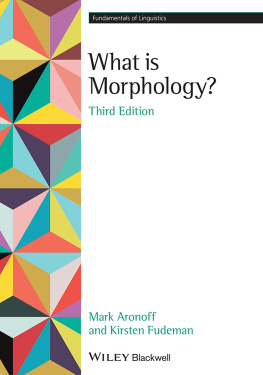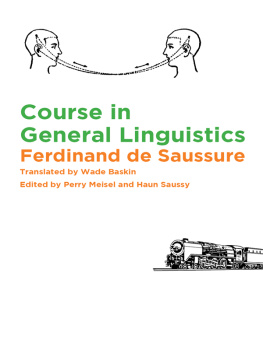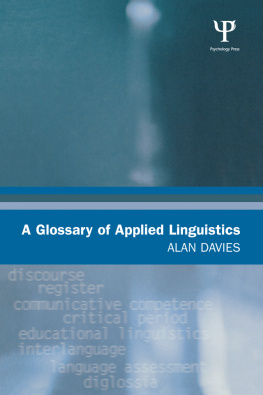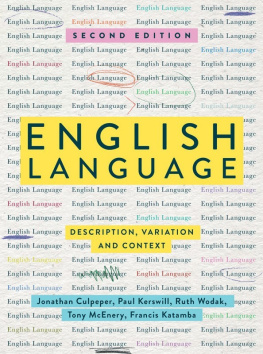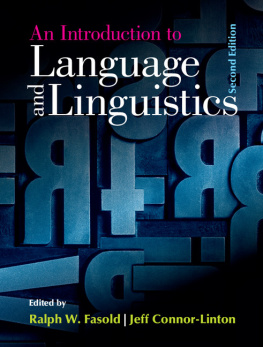LANGUAGE FILES
TWELFTH EDITION
Editors of Previous Editions
11th edition, 2011
Vedrana Mihalicek
Christin Wilson
10th edition, 2007
Anouschka Bergmann
Kathleen Currie Hall
Sharon Miriam Ross
9th edition, 2004
Georgios Tserdanelis
Wai Yi Peggy Wong
8th edition, 2001
Thomas W. Stewart, Jr.
Nathan Vaillette
7th edition, 1998
Nick Cipollone
Steven Hartman Keiser
Shravan Vasishth
6th edition, 1994
Stefanie Jannedy
Robert Poletto
Tracey L. Weldon
5th edition, 1991
Monica Crabtree
Joyce Powers
4th edition, 1987
Carolyn McManis
Deborah Stollenwerk
Zhang Zheng-Sheng
3rd edition, 1985
Anette S. Bissantz
Keith A. Johnson
2nd edition, 1982
Carol Jean Godby
Rex Wallace
Catherine Jolley
1st compilations, 197779
Deborah B. Schaffer
John W. Perkins
F. Christian Latta
Sheila Graves Geoghegan
Language Files
Materials for an Introduction to Language and Linguistics
Twelfth Edition
Editors
Hope C. Dawson
Michael Phelan
Department of Linguistics
The Ohio State University

The Ohio State University Press
Columbus
Copyright 2016 by The Ohio State University.
All rights reserved.
Library of Congress Cataloging-in-Publication Data
Names: Dawson, Hope, editor. | Phelan, Michael, 1980 editor.
Title: Language files : materials for an introduction to language and linguistics / editors, Hope C. Dawson, Michael Phelan (Department of Linguistics, The Ohio State University).
Description: Twelfth edition. | Columbus : The Ohio State University Press, [2016] | Includes bibliographical references and index.
Identifiers: LCCN 2016015920 | ISBN 9780814252703 (pbk. ; alk. paper) | ISBN 0814252702 (pbk. ; alk. paper)
Subjects: LCSH: Linguistics.
Classification: LCC P121 .L3855 2016 | DDC 410dc23
LC record available at https://lccn.loc.gov/2016015920
Cover design by Laurence J. Nozik
Text design by Juliet Williams
Type set in ITC Stone Serif
9 8 7 6 5 4 3 2 1
CONTENTS
The following symbols are used throughout this book; many are also conventionally used in the field of linguistics. For a comprehensive guide to the phonetic symbols used in the book, please refer to the last page.
italics | Indicates that the relevant text is a particular linguistic item being referred to (e.g., The word platypus is a noun). |
bold sans serif | Indicates that the relevant text is an item in the glossary. |
ALL CAPS | With regard to signed languages, indicates that the capitalized text is a sign. In phonetics, indicates that a word in an utterance receives a pitch accent. |
x | Signifies that x is a meaning. |
x | Signifies that x is an utterance. |
Signifies that x is an orthographic representation. |
/x/ | Signifies that x is a phoneme or a phonological form. |
[x] | In phonetics, signifies that x is a phone or allophone or a phonetic form. In syntax, indicates that x is a constituent. |
XP | Denotes a phrase of type X. |
* | In synchronic linguistics, designates an ungrammatical form. In historical linguistics, marks a reconstructed form. |
# | In pragmatics, designates an infelicitous utterance. In phonology, marks a word boundary. |
Marks a syllable boundary. |
+ | Marks a morpheme boundary. |
In phonology, indicates an allophone or a phoneme that has been deleted. In semantics, indicates a set with no members. |
In phonology, denotes becomes. In syntax, denotes may consist of (or, in more formal theories, dominates or is the mother of). |
> | In historical linguistics, denotes changes into. |
< | In historical linguistics, denotes derives from. |
C | Represents any consonant. |
V | Represents any vowel. |
N | Represents any nasal. |

| Indicates that an answer to a particular question in a Practice file can be found in the appendix. |

| Indicates that a relevant URL can be found at http://linguistics.osu.edu/research/pubs/lang-files/links. |

| Indicates that a relevant sound file can be found at http://linguistics.osu.edu/research/pubs/lang-files/sounds. |

| Indicates that a relevant video file can be found at http://linguistics.osu.edu/research/pubs/lang-files/videos. |
An Introduction to Language Files
Since its inception almost forty years ago, Language Files has grown from a collection of materials designed simply as a supplement for undergraduate courses into a full-fledged introductory textbook. The scope of the text makes it suitable for use in a wide range of courses, while its unique organization into instructor-friendly files allows for tremendous flexibility in course design.
Language Files was originally the idea of Arnold Zwicky, who was among its first authors. Since the first edition, many editors have contributed to the development of Language Files ; the current edition is the result of this cumulative effort.
Changes in the Current Edition
In this edition, we have revised, clarified, and updated many of the existing files and the accompanying exercises. We have also substantially updated the accompanying online resources, and we have added icons next to the text to inform the reader of particular places where additional resources are available on our website. The speaker icon  , video icon
, video icon  , and link icon
, and link icon  indicate that sound files, video files, and relevant URLs can be found at
indicate that sound files, video files, and relevant URLs can be found at
http://linguistics.osu.edu/research/pubs/lang-files/sounds,
http://linguistics.osu.edu/research/pubs/lang-files/videos, and
http://linguistics.osu.edu/research/pubs/lang-files/links, respectively.
The cartoons accompanying each file have also been replaced with original artwork by Julia Porter Papke.
In addition to these global changes, the following chapters have undergone significant revision or changes.
: Introduction
Introducing the Study of Language now includes a section providing helpful hints on how to use this book.
Other (Non-Essential) Aspects of Knowing a Language has been renamed and revised to clarify the relationship of writing and prescriptive grammar to the study of language. The discussion of writing has also been updated to reflect the prevalence of electronic communication, and the discussion of prescriptive grammar has been revised to clarify the distinction between prescriptive and descriptive grammars, among other things.

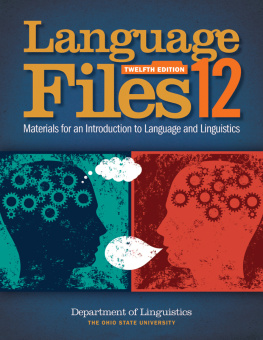
![Andrew Radford - Linguistics An Introduction [Second Edition]](/uploads/posts/book/882994/thumbs/andrew-radford-linguistics-an-introduction.jpg)
